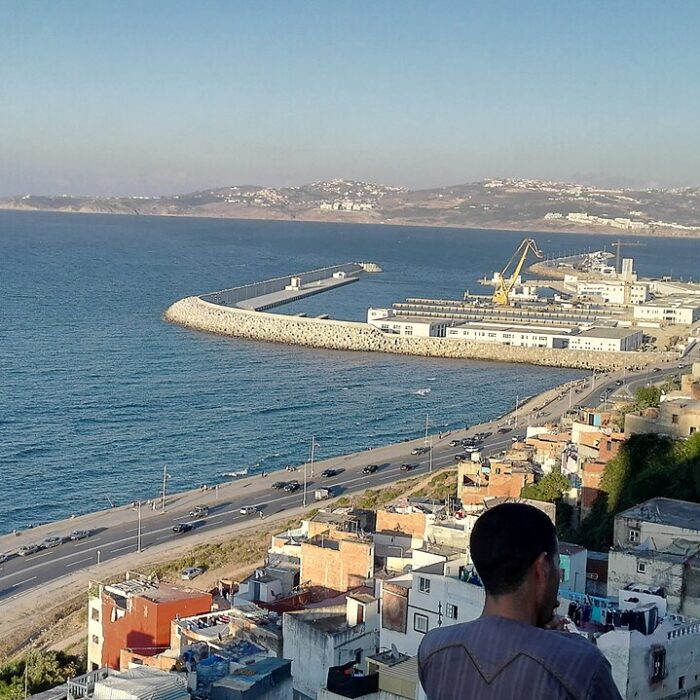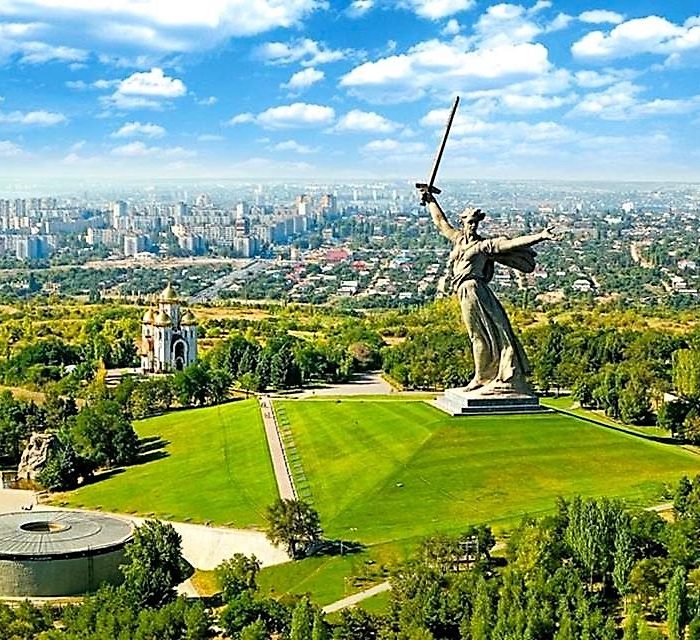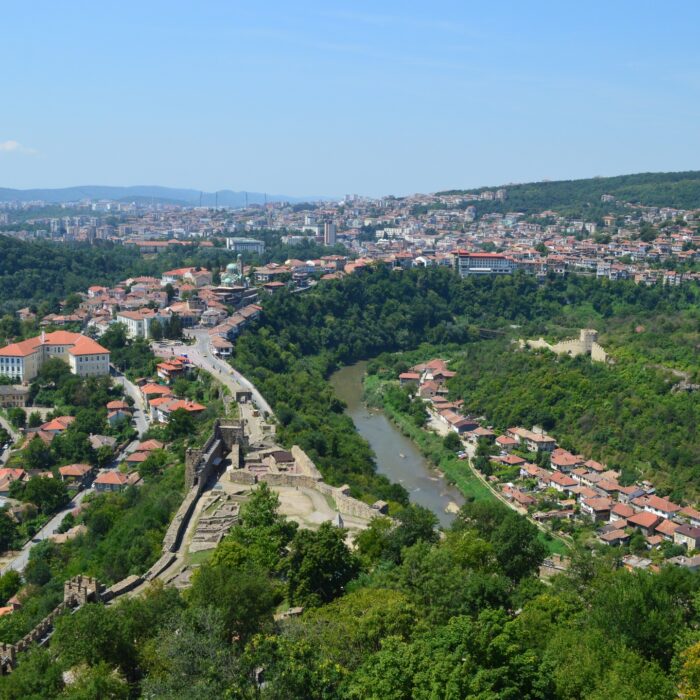Laos is a fantastic destination for exploring landmarks and attractions. The country boasts a rich cultural and historical tapestry, with numerous noteworthy sites to visit. Laos is home to several UNESCO World Heritage Sites, including the historic town of Luang Prabang, renowned for its well-preserved architecture and religious sites. The Plain of Jars, an archaeological landscape, is another UNESCO-listed site, offering a unique and intriguing experience. Overall, Laos provides a diverse range of cultural, natural, and historical attractions, making it a compelling destination for travelers seeking a distinctive and enriching journey. Here’s a list of the best attractions in laos to visit.
1. Kuang Si Waterfall: A Natural Marvel in Laos
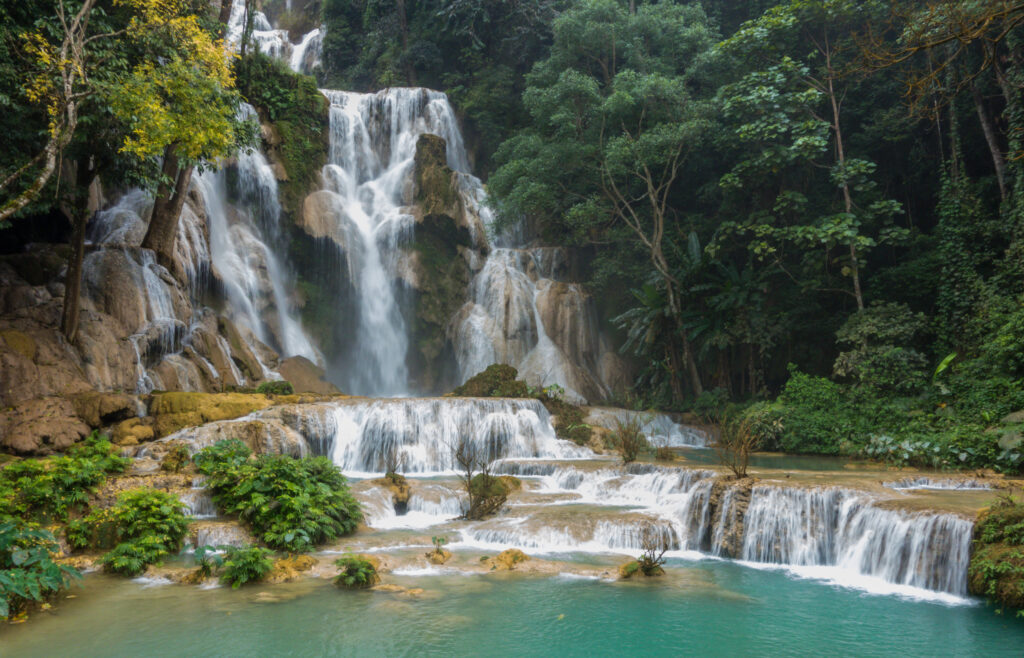
Nestled in the lush landscapes near Luang Prabang, the Kuang Si Waterfall is a captivating natural wonder. Cascading down tiers of limestone formations, the turquoise blue pools at the base create a mesmerizing sight. Visitors can take a refreshing dip in the cool waters or explore the surrounding trails for panoramic views. With its serene ambiance and stunning beauty, Kuang Si Waterfall stands as a must-visit destination, offering a tranquil escape into Laos’ natural splendor.
Best Time to Visit: Visit Kuang Si Waterfall during the dry season from November to April for optimal conditions. During this period, the water is crystal clear, and the weather is pleasant for exploration.
Getting There: Located approximately 29 kilometers south of Luang Prabang, reaching Kuang Si is easily possible by tuk-tuk, taxi, or motorbike. Enjoy a scenic journey through the Laotian countryside.
Exploration Tips:
- Trail Adventures: Explore the well-marked trails around the waterfall, offering stunning viewpoints.
- Swimming Delight: Don’t forget to bring your swimsuit for a refreshing dip in the turquoise pools.
- Butterfly Park: Visit the nearby Butterfly Park, showcasing Laos’ diverse butterfly species.
2. Arc de Triomphe of Vientiane
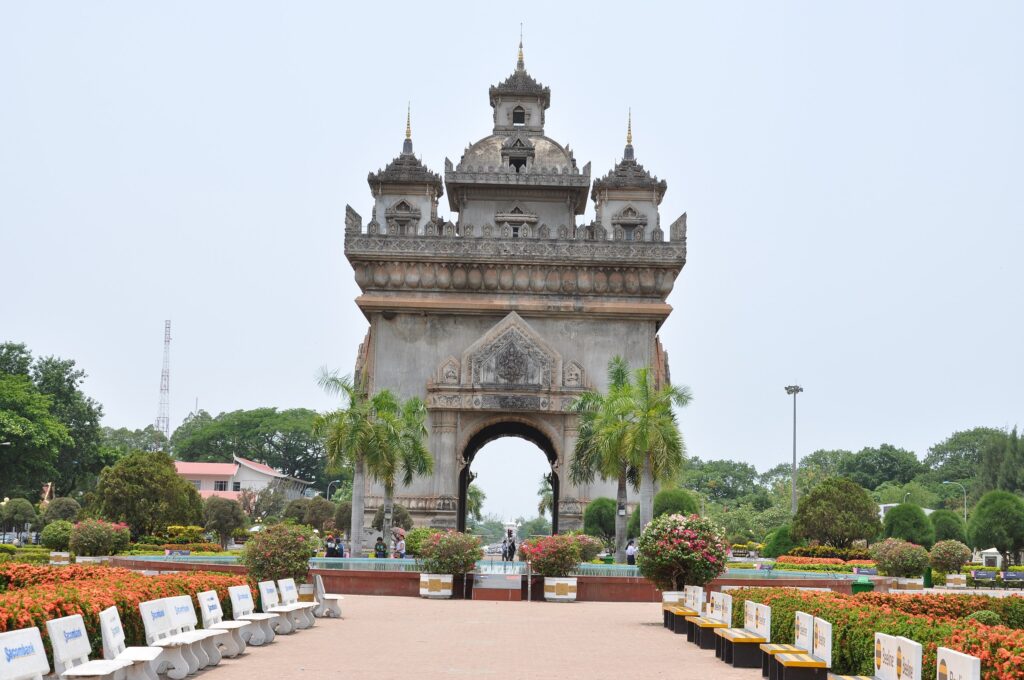
Patuxay, Vientiane’s own Arc de Triomphe, showcases intricate Laotian design. Built in the 1960s, it commemorates independence and stands as a symbol of national pride. Delve into the monument’s history, symbolizing Laos’ struggle for independence. Gain insights into the nation’s past and appreciate the craftsmanship. Surrounding Patuxay Park provides a serene escape, while nearby markets offer local crafts. Immerse yourself in Laotian culture as you wander through these vibrant spaces.
Best Time to Visit: Optimal visits are during early mornings or late afternoons when the sunlight enhances the monument’s details and offers a pleasant atmosphere.
Photography Highlights: Capture the monument’s ornate details and consider ascending for panoramic views. Sunset adds a golden hue, creating stunning photo opportunities.
Pro Tip: Weekday visits offer a quieter experience, allowing you to appreciate the monument and its surroundings with more tranquility.
3. That Luang: Laos’ Golden Stupa
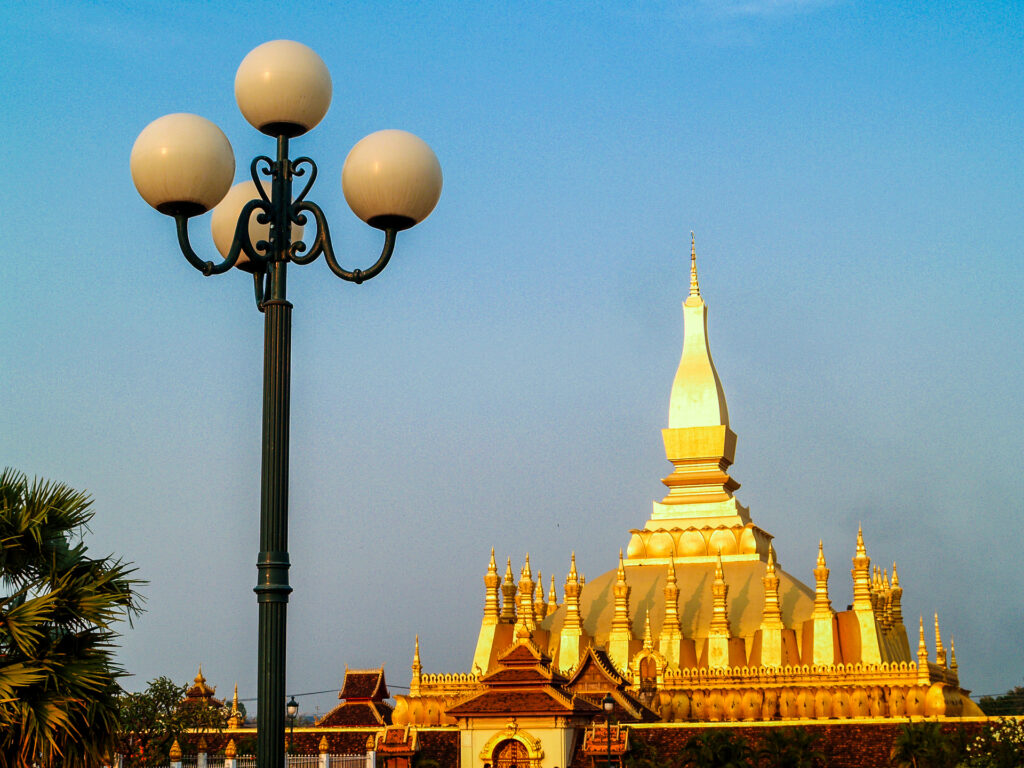
That Luang, often referred to as the “Great Stupa,” is a symbol of national identity. Its golden exterior gleams under the sun, showcasing traditional Laotian design. Built in the 16th century, That Luang is a revered Buddhist monument and a symbol of Lao sovereignty. Delve into its rich history and embrace the spiritual ambiance. Wander through the serene temple grounds and take in the atmosphere of spirituality. Nearby markets offer insights into local life and crafts.
Best Time to Visit: Experience That Luang’s magnificence during sunrise or sunset when the golden hue is particularly enchanting. The cooler temperatures enhance your exploration of this sacred site.
Photography Highlights: Capture the grandeur of That Luang against the changing sky hues. Explore the intricate details of the stupa and the surrounding gardens for captivating shots.
Pro Tip: Visit during important Buddhist festivals, like Boun That Luang, to witness lively celebrations and gain a deeper cultural understanding.
4. Wat Xieng Thong: Tranquil Elegance in Luang Prabang
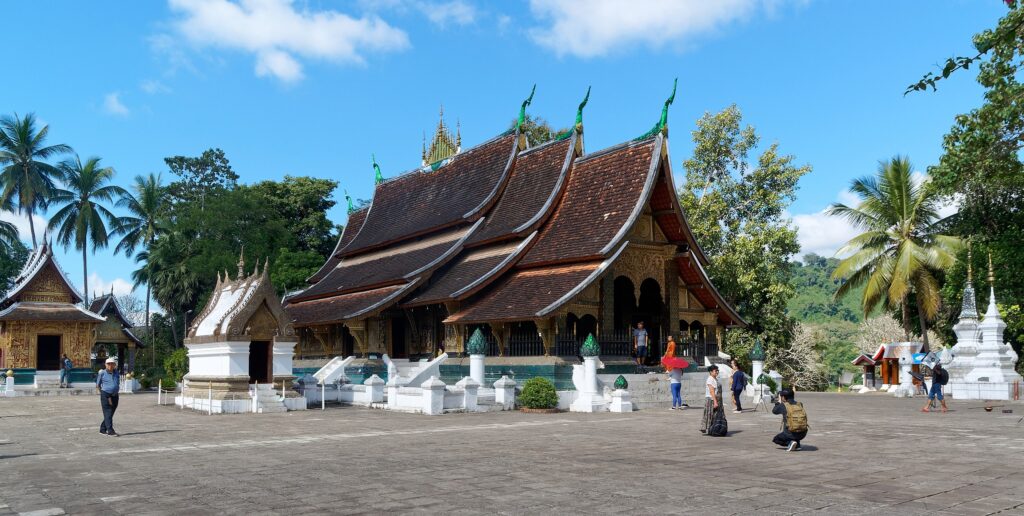
Wat Xieng Thong, nestled in the heart of Luang Prabang, is a masterpiece of Lao temple architecture. Its intricate design and golden façade reflect the rich cultural heritage of Laos. Dating back to the 16th century, Wat Xieng Thong is a significant religious site. It served as the coronation site for Lao kings and stands as a symbol of Buddhism’s influence. Stroll through the temple grounds and the adjoining chapels. The sim, or ordination hall, showcases the elegance of Laotian architecture. Don’t miss the royal funeral carriage hall housing intricate artifacts.
Best Time to Visit: Embrace the serene ambiance during early morning visits when the temple basks in soft sunlight. Sunset also provides a magical glow to this spiritual haven.
Photography Highlights: Capture the detailed carvings, mosaic work, and the iconic “Tree of Life” mosaic on the exterior. The interior, adorned with historic murals, offers captivating photography opportunities.
Pro Tip: Visit during Buddhist ceremonies or festivals for an immersive cultural experience. Respect local customs and the serene nature of the temple.
5. Wat Phou in Southern Laos

Wat Phou, a UNESCO World Heritage Site, stands as a testament to Khmer architecture. Set against a mountain backdrop, this ancient temple complex exudes grandeur. Dating back to the 11th century, Wat Phou served as a center for worship and pilgrimage. Its alignment with celestial bodies showcases advanced Khmer engineering. Follow the stone pathways through the complex, discovering shrines, pavilions, and the imposing main sanctuary. The sacred spring and Lingaparvata mountain add to the spiritual aura.
Best Time to Visit: Explore Wat Phou during the early morning or late afternoon to witness the site’s beauty in the gentle sunlight. The cooler temperatures enhance the experience of wandering through this historical sanctuary.
Photography Highlights: Capture the intricate carvings, imposing stone structures, and the panoramic views from the site. The ambiance changes with the sunlight, offering a variety of captivating shots.
Pro Tip: Combine your visit with the annual Wat Phou Festival for an immersive cultural experience, featuring traditional performances and processions.
6. Buddha Park in Xieng Khuan

Buddha Park, or Xieng Khuan, situated on the banks of the Mekong River near Vientiane, is a mesmerizing sculpture park where artistry and spirituality converge in a unique landscape. Created in 1958 by a mystic monk, the park blends Buddhist and Hindu iconography, offering visitors a unique perspective on the interconnectedness of these spiritual traditions. Meander through the park’s open-air gallery, where you’ll encounter giant sculptures, including a reclining Buddha and a massive pumpkin structure. Ascend the pumpkin for panoramic views.
Best Time to Visit: Opt for late afternoon to witness the sculptures bathed in warm sunlight. The park’s serene atmosphere during this time enhances the contemplative experience.
Photography Wonderland: Capture the diverse collection of Buddha and Hindu deity sculptures. Each statue tells a story, making every angle a potential masterpiece for your camera lens.
Pro Tip: Take a moment for quiet reflection amidst the sculptures. The park’s atmosphere provides an opportunity for a serene connection with art and spirituality.
7. Lao Textile Museum
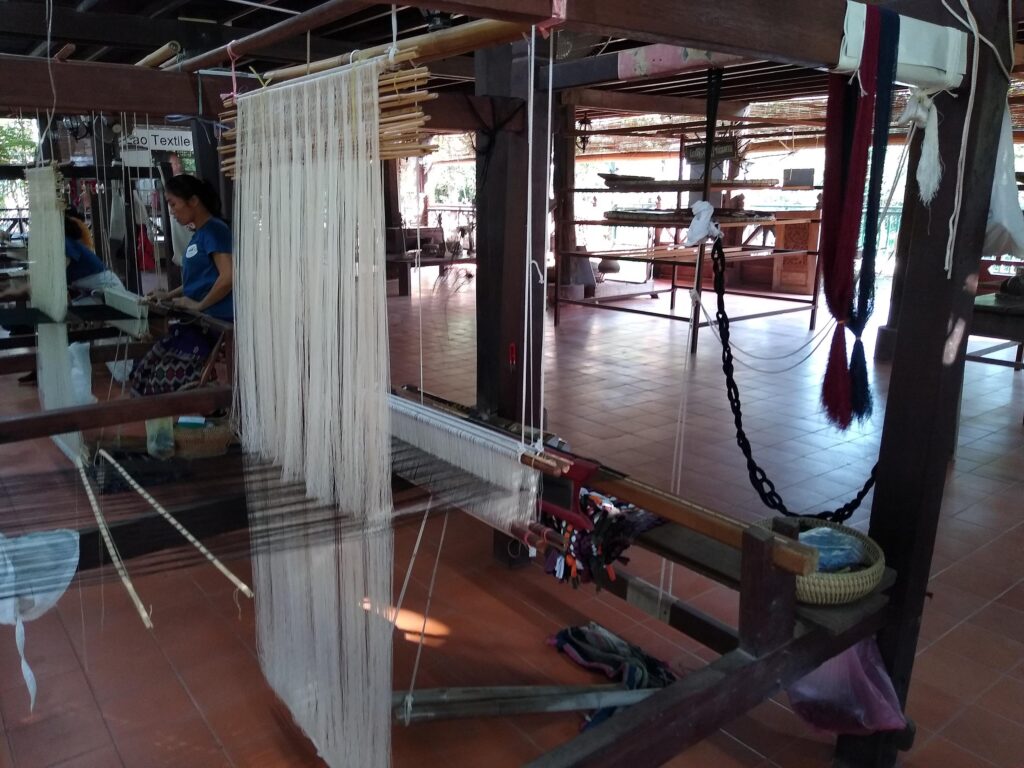
Immerse yourself in Laos’ rich textile heritage at the Lao Textile Museum. Explore intricate patterns, traditional weaving techniques, and the vibrant stories woven into every thread. Discover the significance of textiles in Lao culture, from ceremonial garments to everyday fabrics. The museum is a testament to the preservation of this timeless craft, showcasing the skill and artistry of Lao weavers.
Opening Hours: Explore the Lao Textile Museum’s rich tapestry from Tuesday to Sunday, between 9 AM and 5 PM. Plan your visit during the morning or late afternoon for a leisurely and immersive experience.
Gift Shop: Extend your cultural journey by exploring the museum’s gift shop. Take home a piece of Lao heritage with unique, handmade textiles, supporting local artisans and preserving this age-old craft.
Special Events: Check for special events or exhibitions that may coincide with your visit, offering an opportunity to witness live demonstrations, interact with weavers, and dive even deeper into the artistry of Lao textiles.
8. Phu Si Sacred Hill in Luang Prabang

Phu Si, gracing the center of Luang Prabang, is a sacred hill crowned by the revered Wat Chom Si. The climb offers panoramic views of the city and the Mekong River, making it a spiritual and visual delight. Phu Si holds deep spiritual significance for the locals, housing gilded stupas and statues. Wat Chom Si, at the hill’s summit, provides a peaceful space for meditation and reflection. Wander through the hill’s lush greenery and visit the various shrines and statues along the way. Wat Tham Phou Si, a cave temple, adds to the mystique of the ascent.
Best Time to Visit: Ascend during the late afternoon to witness the sun setting over Luang Prabang. The hill’s serene ambiance during this time adds a magical touch to the spiritual experience.
Panoramic Photography: Capture the breathtaking views from the hill’s summit, where the Mekong and Nam Khan Rivers converge. The golden glow of sunset creates a picturesque backdrop for your photographs.
Pro Tip: While the climb can be steep, the spiritual rewards and the panoramic views make it a must-do experience in Luang Prabang. Consider taking the ascent at a leisurely pace.
9. Tat Sae Waterfalls

Tat Sae Waterfalls, located near Luang Prabang, is a hidden gem amidst lush jungles. The multi-tiered cascades create a picturesque landscape, offering a tranquil escape into nature. Escape the bustling city and immerse yourself in the peaceful ambiance. Tat Sae offers a serene setting for picnics, relaxation, and a refreshing dip in its natural pools. Embark on a nature hike to explore the falls and the surrounding area. Discover hidden pools, scenic viewpoints, and the diverse flora and fauna that thrive in this pristine environment.
Best Time to Visit: Plan your visit during the wet season (June to October) when the waterfalls are at their most robust and the surrounding greenery is in full bloom.
Photography Oasis: Capture the mesmerizing beauty of the waterfalls against the backdrop of the dense forest. Each tier provides a unique angle for stunning photographs.
Pro Tip: Visit during the early morning or late afternoon to avoid crowds and experience the falls in a more serene atmosphere. Combine your visit with nearby attractions for a full day of exploration.
10. Chao Anouvong Park in Vientiane

Chao Anouvong Park, located along the Mekong River in Vientiane, is a green haven offering respite from the city’s hustle. Named after the Laotian monarch, it combines scenic beauty with historical significance. The park features a prominent statue of King Chao Anouvong, a revered figure in Laotian history. Explore the statue’s details and embrace the park’s homage to the country’s heritage. Take a leisurely stroll along the riverside promenade or through the well-maintained paths within the park. Enjoy the blend of urban aesthetics and natural tranquility.
Best Time to Visit: Enjoy the park during the early morning or late afternoon when the weather is cooler. The riverside sunset view adds a magical touch to your visit.
Picturesque Views: Capture the breathtaking scenery of the Mekong River and the iconic Anouvong Statue, especially as the sun sets. The park’s landscaping provides a picturesque backdrop for memorable photographs.
Pro Tip: Consider visiting on weekends when the park comes alive with locals enjoying picnics, cultural performances, and the vibrant atmosphere along the river.
11. Phou Khao Khouay

Phou Khao Khouay, Laos’ national biodiversity conservation area, is a haven for nature enthusiasts. This untouched expanse of wilderness, located near Vientiane, boasts diverse ecosystems and rare wildlife. Learn about the conservation efforts within the park, aimed at preserving its unique biodiversity. Gain insights into the importance of sustaining Laos’ natural heritage. Embark on guided treks along well-maintained trails, immersing yourself in the park’s natural wonders. Discover hidden waterfalls, vibrant birdlife, and possibly elusive wildlife.
Best Time to Visit: Explore during the dry season (November to March) for comfortable trekking conditions and increased chances of wildlife sightings. The lush greenery during the wet season (June to October) is equally enchanting.
Nature’s Canvas: Capture the rich biodiversity, from dense jungles and pristine waterfalls to rare species of flora and fauna. The park’s landscapes offer a photographer’s paradise.
Pro Tip: Secure a knowledgeable guide for a richer experience. Respect park regulations to minimize environmental impact and contribute to the preservation of this pristine natural gem.
12. Kong Lor Cave

Kong Lor Cave, nestled in central Laos, is a geological wonder carved by the Hinboun River. This colossal limestone cave stretches over 7 kilometers, creating an otherworldly experience for intrepid explorers. Engage with local guides who share cultural tales and legends associated with Kong Lor Cave. Learn about the cave’s significance in local folklore and its role as a natural marvel. Embark on a guided boat journey through the dark abyss, illuminated only by the boat’s headlights. Traverse the cave’s impressive length and witness the unique rock formations that adorn its chambers.
Best Time to Visit: Explore during the dry season (November to April) for ideal water levels, enabling boat rides through the cave’s intricate chambers. The cooler temperatures during this period enhance the cave exploration.
Cave Photography Expedition: Capture the surreal beauty of colossal stalactites and stalagmites as your boat glides through the cave’s subterranean river. Bring a waterproof camera to document the mesmerizing underground landscapes.
Pro Tip: Plan your visit during weekdays to avoid crowds. Wear comfortable clothing and be prepared for a sense of awe as you venture into the heart of this subterranean masterpiece.
13. Nam Ha National Bio-Diversity Conservation Area
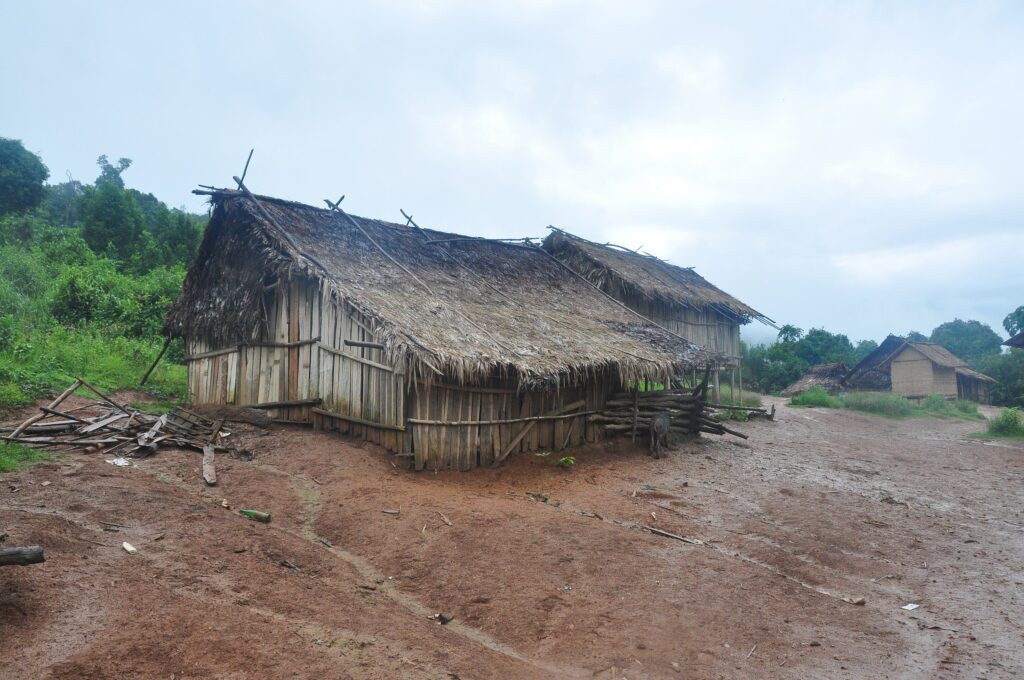
Nam Ha National Bio-Diversity Conservation Area, situated in northern Laos, is a pristine expanse of wilderness dedicated to conserving the country’s rich biodiversity. This protected area offers a haven for diverse ecosystems and rare species. Learn about the conservation initiatives within the park and the efforts to involve local communities in sustainable practices. Support eco-friendly tourism to contribute to the preservation of this vital natural reserve. Embark on eco-friendly treks guided by local experts. Traverse through the park’s diverse terrain, encountering unique plant life, bird species, and, if fortunate, glimpses of elusive wildlife.
Best Time to Visit: Explore during the dry season (November to March) for optimal trekking conditions and increased chances of wildlife encounters. The lush greenery during the wet season (June to October) adds a vibrant touch to the landscapes.
Breathtaking Biodiversity: Capture the beauty of untouched landscapes, from dense forests to meandering rivers. The area is a paradise for wildlife photography, featuring rare species of flora and fauna.
Pro Tip: Respect park regulations, follow sustainable tourism practices, and engage with local communities to gain a deeper understanding of the area’s ecological importance.
14. Wat That Khao

Wat That Khao, located in the lush landscapes of Laos, stands as a serene Buddhist temple, offering a peaceful escape for contemplation and spiritual connection. Discover the cultural and religious significance of Wat That Khao. Engage with locals or temple monks to gain insights into the teachings and practices that define this spiritual sanctuary. Take a leisurely stroll through the temple grounds, exploring the various structures and adorned pavilions. Engage in mindful moments amidst the peaceful surroundings.
Best Time to Visit: Experience the temple’s tranquility during early morning hours when the air is crisp, and the atmosphere is imbued with a sense of calm. The soft sunlight enhances the beauty of the surroundings.
Architectural Elegance: Capture the architectural details of the temple, from intricate carvings to the serene Buddha statues. The temple’s design reflects traditional Lao aesthetics, creating a picturesque setting.
Pro Tip: Respect the temple’s sacred space by dressing modestly and observing any local customs. Consider visiting during Buddhist ceremonies to witness traditional rituals.
15. Wat Phousalao
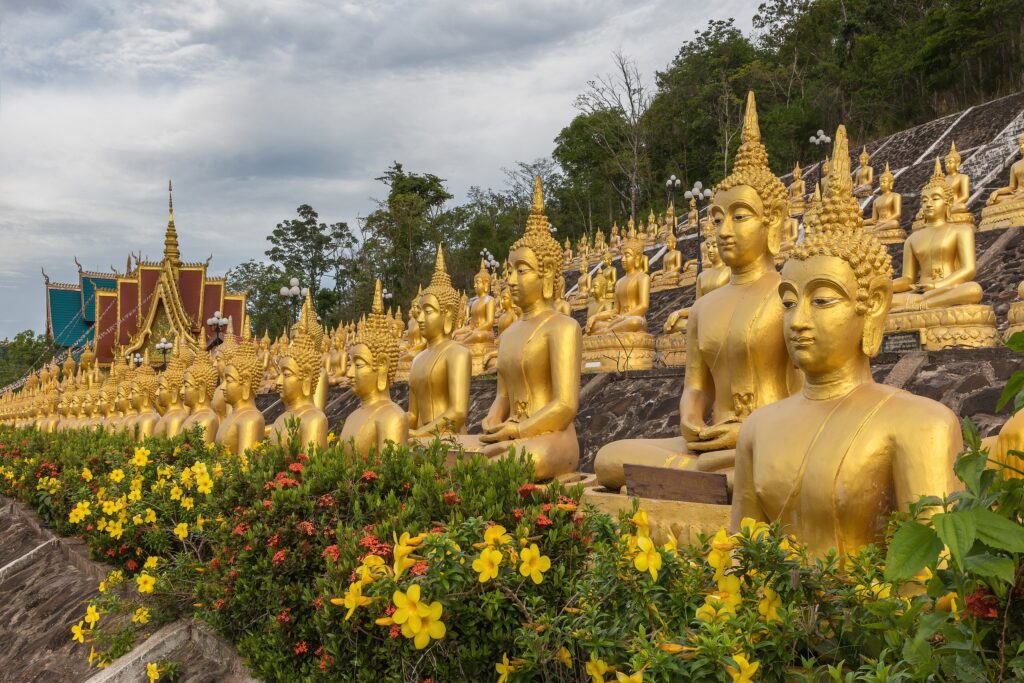
Wat Phousalao, perched atop Phousi Hill in Luang Prabang, is a revered Buddhist temple offering panoramic views of the city and the Mekong River. This spiritual sanctuary holds a special place in the heart of Laos. Engage with resident monks to learn about the temple’s cultural and historical significance. Wat Phousalao holds stories that echo the deep-rooted spirituality of Luang Prabang. Embark on the stairway ascent to Wat Phousalao, a symbolic journey representing spiritual elevation. Explore the temple’s ornate architecture and discover tranquil corners for reflection.
Best Time to Visit: Ascend the hill during early morning or late afternoon to witness a breathtaking sunrise or sunset. The changing hues of the sky create a serene atmosphere, enhancing the spiritual experience.
Scenic Serenity: Capture the captivating vistas of Luang Prabang from the temple grounds. The iconic golden stupa and surrounding structures provide a picturesque foreground against the backdrop of the city.
Pro Tip: Visit during the annual Boun Ok Phansa festival, celebrated at the end of Buddhist Lent, for a unique cultural experience. Respect the temple’s sacred atmosphere and adhere to any local customs.
16. Wat Wisunarat
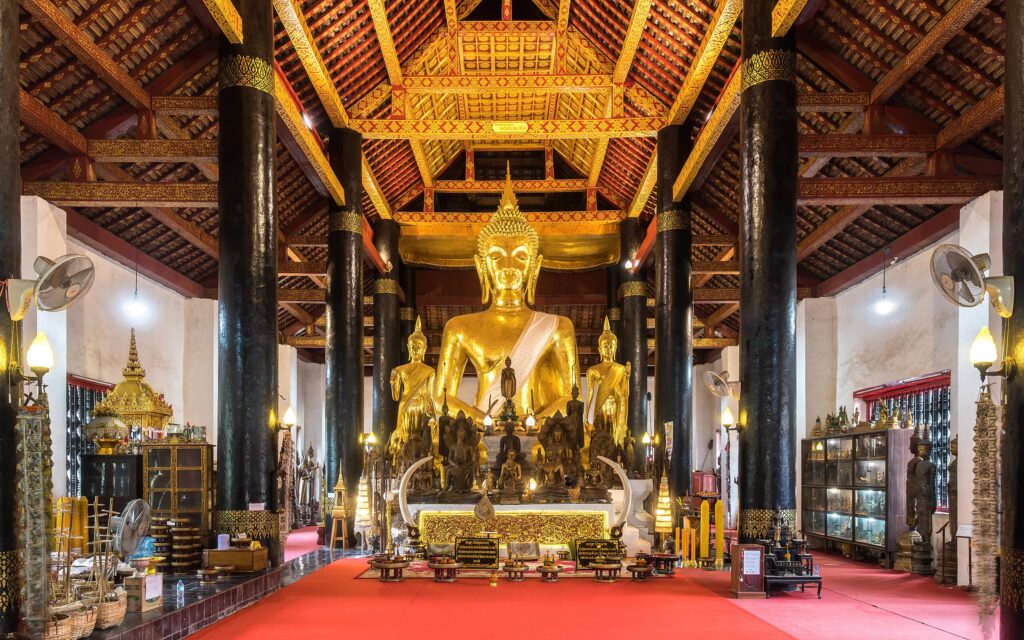
Wat Wisunarat, also known as Wat Visoun, is one of Luang Prabang’s oldest temples, steeped in history and cultural significance. This sacred site stands as a testament to Laos’ enduring spiritual heritage. Discover the tales embedded in the temple’s history, including its survival through wars and invasions. Engage with locals or monks to gain insights into the spiritual teachings and practices. Wander through the temple grounds, exploring the collection of ancient Buddha images and religious artifacts. The peaceful courtyards offer a serene space for quiet contemplation.
Best Time to Visit: Immerse yourself in the temple’s tranquil aura during the early morning or late afternoon. The softer light enhances the ancient beauty of the architecture and sculptures.
Architectural Grandeur: Capture the timeless elegance of Wat Wisunarat’s architecture, characterized by intricate carvings and a distinctive stupa. The temple’s structures reflect the artistic prowess of bygone eras.
Pro Tip: Visit during important Buddhist festivals, such as Boun Pi Mai (Lao New Year), to witness vibrant celebrations and cultural rituals. Respect the sacred nature of the temple during your exploration.
17. That Ing Hang

That Ing Hang, located in Savannakhet Province, stands as a revered stupa and a spiritual center for the local community. This ancient structure holds deep religious significance in the heart of southern Laos. Learn about the cultural and religious significance of That Ing Hang from local monks or guides. Discover the stories and traditions that have shaped this spiritual landmark. Embark on a journey around the stupa, following the pilgrimage path. The serene surroundings and the rhythmic chants contribute to a meditative experience.
Best Time to Visit: Bask in the peaceful ambiance of That Ing Hang during early morning or late afternoon. The subtle sunlight accentuates the stupa’s architectural details, creating a serene atmosphere.
Architectural Splendor: Capture the intricate details of the stupa, adorned with traditional motifs and symbols. The golden hue of the structure against the backdrop of the sky provides a compelling subject for photography.
Pro Tip: If possible, plan your visit during the That Ing Hang Festival, where the stupa becomes a focal point for lively celebrations, traditional performances, and religious ceremonies.
18. Wat May Souvannapoumara

Wat May Souvannapoumaram, nestled in the heart of Luang Prabang, is a cultural treasure, embodying the intricate beauty of Laotian temple architecture and spirituality. Delve into the historical and spiritual significance of Wat May. Learn about its role in local ceremonies, festivals, and the cultural tapestry of Luang Prabang. Take a leisurely stroll through the temple grounds, where you’ll encounter lush gardens and well-maintained courtyards. The ambiance invites contemplation and peaceful exploration.
Best Time to Visit: Experience the serene beauty of Wat May during the early morning or late afternoon. The soft sunlight enhances the golden hues of the temple and creates a tranquil atmosphere.
Architectural Elegance: Capture the ornate details of the temple’s façade, adorned with intricate carvings, gilded accents, and traditional motifs. The craftsmanship reflects the rich heritage of Laos.
Pro Tip: Visit during traditional Lao festivals, such as Boun Pi Mai (Lao New Year) or Boun Bang Fai (Rocket Festival), to witness the vibrant cultural celebrations that unfold within the temple grounds.
19. Manifa Elephant Camp
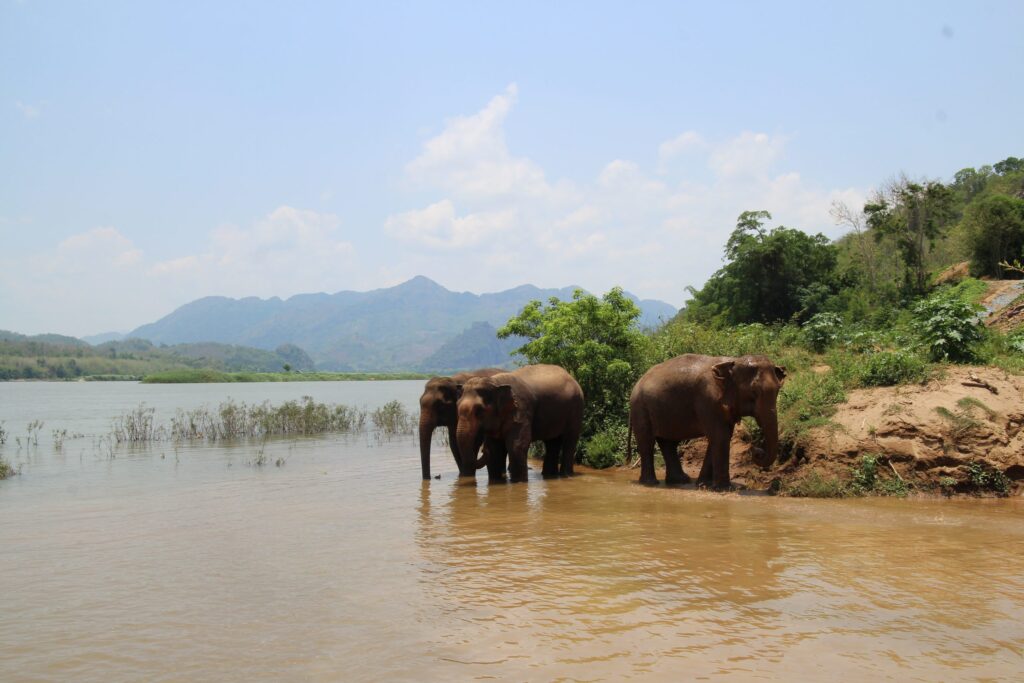
Manifa Elephant Camp, nestled in the lush landscapes of Laos, is a haven for elephants and nature enthusiasts alike. This ethical and conservation-focused camp provides a unique opportunity to connect with these majestic creatures. Engage with the camp’s conservation initiatives, aimed at protecting and preserving the well-being of elephants. Learn about their rehabilitation programs and the role of responsible tourism in supporting these efforts. Embark on guided nature walks through the camp’s surroundings. Learn about the flora and fauna of the region while gaining insights into the camp’s conservation efforts.
Best Time to Visit: Experience the camp’s serenity during the cool mornings or late afternoons. Witnessing the elephants in their natural environment during these times enhances the overall experience.
Ethical Encounters: Capture the beauty of elephants in their natural habitat. The camp prioritizes ethical interactions, allowing visitors to observe and appreciate the animals’ natural behaviors without exploitation.
Pro Tip: Participate in feeding and bathing activities, fostering a sense of connection with the elephants. Respect the camp’s guidelines to ensure the welfare of the animals and the sustainability of conservation efforts.
20. Mekong Elephant Park Sanctuary

Mekong Elephant Park Sanctuary, nestled along the Mekong River, is a refuge for elephants, offering a compassionate and ethical environment where these majestic creatures can thrive. Engage with the sanctuary’s commitment to elephant welfare and conservation. Discover how responsible tourism contributes to the well-being of elephants and supports broader conservation initiatives. Embark on guided tours led by knowledgeable staff who provide insights into elephant behavior, their ecological importance, and the conservation efforts in place. Learn about the individual stories of each resident elephant.
Best Time to Visit: Explore the sanctuary during the cool mornings or late afternoons when the elephants engage in various activities. The serene atmosphere enhances the overall experience.
Ethical Encounters: Capture the natural behaviors of elephants in their protected habitat. The sanctuary focuses on ethical interactions, allowing visitors to observe these gentle giants in a respectful and nurturing setting.
Pro Tip: Participate in activities that prioritize the elephants’ natural behaviors, such as observing them graze, interact, and bathe. Support the sanctuary’s mission by respecting guidelines for responsible and sustainable tourism.
21. Plain of Jars: Mystical Megalithic Marvels
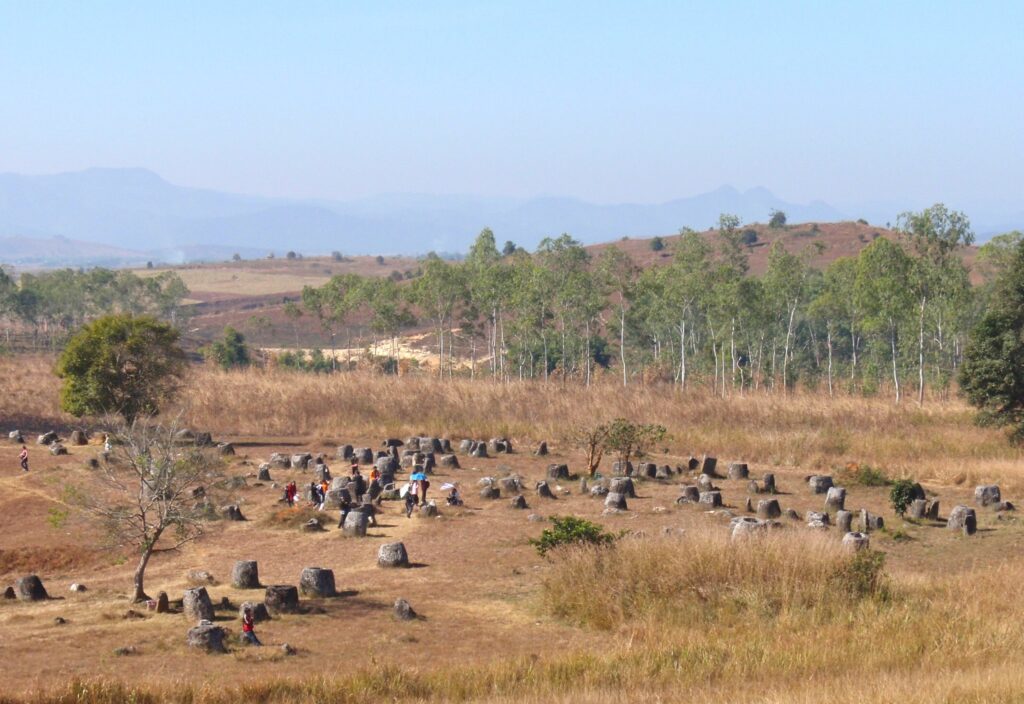
Embark on a journey to the mysterious Plain of Jars, an archaeological site in Laos. Marvel at the enigmatic giant stone jars scattered across the landscape, each bearing tales of ancient civilizations. Delve into the mysteries surrounding the purpose of these jars, believed to be linked to burial practices or ancient rituals. Uncover the secrets of this UNESCO World Heritage site, offering a glimpse into Laos’ enigmatic past.
Exploration Time: Plan your visit during the dry season, from November to April, for optimal exploration conditions. Guided tours provide insights into the history and significance of these ancient relics.
Photographer’s Paradise: Capture the haunting beauty of the jars set against the backdrop of lush greenery. The site’s unique ambiance offers a photographer’s dream, making it a must-visit for history enthusiasts and shutterbugs alike.
Exploring Laos: Transportation and Tours
Laos offers a diverse tapestry of attractions, and navigating its landscapes involves considerations of transportation and tour options. The country’s transport infrastructure is improving, with buses connecting major cities and local options like tuk-tuks for shorter distances. While self-driving can be adventurous, road conditions and remoteness should be considered, making local drivers or guided tours a more comfortable choice. If you are still planning to travel independently to the best places in Laos, check the need for an International Driver’s License in Laos to drive with your national license.
Opting for guided tours enhances the travel experience, especially in remote areas or for cultural immersion. Local guides provide insights, navigate challenging terrains, and facilitate a deeper connection with the places visited. Engaging with locals becomes more accessible through guided tours, offering genuine cultural exchanges that enrich your journey.
Depending on your preferred vacation, choose the best time to visit Laos. Few people enjoy the rainy season when it rains continuously. This will complicate the logistics and can mar the experience of the country. We hope this guide to the best tourist attractions in Laos has helped you make plans and been useful.

Published January 31, 2024 • 21m to read


